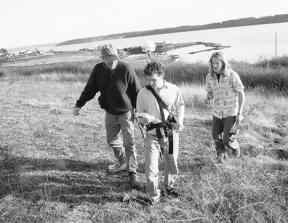In early October, a fire erupted on Grasser’s Hill near the old San de Fuca school house, scorching the grassy hillside.
It took firefighters four hours to extinguish the blaze. There were no injuries and nearby homes were spared any damage, but now it looks like the fire provided at least one benefit.
Native flower enthusiasts hope the burned land will help restore the populations of Western Blue Flag (Iris missouriensis). Grasser’s Hill is believed to be one of the last spots where the rare flower grows.
Pat de La Chapelle, representing the Native Plant Society, hopes that the wild flower will thrive on the hill because of all the other plants destroyed in the fire.
“It’s getting rid of the competition,” de La Chapelle, adding that thistle and wild rose were some of the competing plants that were growing on the hill.
Ebey’s Landing National Historical Reserve Manager Rob Harbour said Native Americans used fire to control the plants that grew on prairies.
He added that controlled fires were recently used on San Juan and Yellow Island but such an activity is also very difficult to coordinate.
“This is like a gift, especially since no property was damaged,” Harbour said of the burned field.
On Tuesday afternoon, de La Chapelle, Harbour and volunteers from Coupeville High School Honor Society were out on Grasser’s Hill surveying the land.
They used a global positioning system borrowed from Au Sable Institute to help produce an accurate map of the burned land.
For Hannah Rodrigues, a high school junior, it was the first time she had used GPS equipment.
“It’s kind of nice that the Honor Society gives an opportunity to do something like this,” Rodrigues said.
Along with Rodrigues, high school seniors Greg Kelly, Drew Dodge and Kyall Hagemeyer participated in the mapping.
Harbour said an accurate map is needed to provide a comparison point between the growth inside and outside of the burn area. This way, it can be determined if the fire improved growing conditions for the Blue Flag.
The Oak Harbor Garden Club donated $2,000 for the project, Harbour said.
The Oct. 11 fire burned 18 acres of land. Although no property was damaged, it did get close enough for neighboring homeowners to grab garden hoses and start spraying.
“The worst part was that I was choked up and couldn’t see a thing,” said Marsha Rowell, a nearby home owner. She said an orchard was damaged by the fire, but the fire moved so fast that it didn’t cause any permanent damage and she hopes the trees will grow back.
While the burn also destroyed some of the irises growing on Grasser’s Hill, de La Chapelle said that she fortunately collected seeds off the hill two weeks before the fire.
She gave them to volunteers from the Honor Society for a restoration project.
“The overall project is to restore part of Ebey’s prairie back to its original state,” Hagemeyer said.
The students began their project at the beginning of the school year. They built propagation beds for the plants and hope to eventually transplant the flowers to various areas in the reserve.
Following April showers, the students are hoping for some native May flowers.



